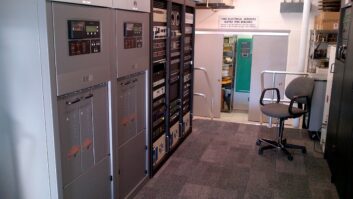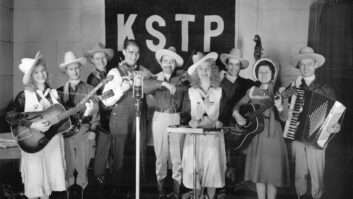Frequency selective levelmeters, also known as frequency selective voltmeters, are commercially-built receivers used in the power utility industry for maintenance and troubleshooting.
They have been on the scene for decades and were manufactured by venerable firms including Cushman, Lear Siegler, Rycom, Philco, EIP, Hewlett-Packard, Wandel & Golterman, Anritsu, etc.
With the passage of time and the evolution of new, upgraded models, these wonderful, vintage archetypes of electronic craftsmanship and design eventually get yanked from the field and transition to the world of the hereafter, i.e., a secondary market for reincarnation by hobbyists and tinkerers at prices that are a fraction of their original cost.
In short, these units can be appropriated from electronics resellers, classified ads and online auction sites to be repurposed as functional long-wave, medium-wave and shortwave receivers that can serve as tabletop radios or carried into the field for outdoor listening.

As with older radio equipment from several decades ago, classic frequency selective levelmeters possess all the physical attributes of what can be called a “boat anchor,” a term of endearment that describes a very large and heavy radio, basically one with ample avoirdupois to function as an actual boat anchor.
But as the old saw goes, beauty is in the eyes of the beholder; and some hobbyists purposely seek out the old-school charm of these supersized and weighty rigs festooned with many knobs, switches, buttons, D’Arsonval signal level meters, a speaker and an assortment of connections for antennas and headphones.
The receiving range of levelmeters will depend on the make and model but most cover from about 10 kHz to a few MHz. More expensive versions range up to 30 MHz. Receive modes are Amplitude Modulation, Lower Sideband and Upper Sideband, which are the modes of primary interest to radio hobbyists.
SIERRA 303B
After a few months of beating the bushes via eBay auctions, placing ads in ham classifieds and checking inventory of electronics resellers, I purchased a Sierra 303B frequency selective levelmeter for a tad below $60.
The Sierra 303B debuted circa 1974, covers a frequency range of 9 kHz–3.3 MHz, has AM/LSB/USB mode selection, a large (4 in. x 3 in.) signal meter that’s internally calibratable, selectable input levels (handy for pulling in weak stations or to prevent signal overload), a frequency display to 0.1 kHz and coarse/fine tuning controls.
It’s rather large, measuring 17 in. x 7 in. x 14 in. and tipping the scale at 30 pounds, which includes the 12 internal “D” rechargeable batteries.
That’s another plus; the Sierra 303B has a built-in battery charger, much like other frequency selective levelmeters, allowing use in the field for those on the go. My particular unit still had ancient NiCad (Nickel-Cadmium) batteries from 1994 installed, which ultimately will be replaced.
The radio is solidly constructed and housed in a metal case with a latching front cover and handle. A tilt bail adds to the commanding presence it exudes on my shack desk and it proudly exhibits the usual visible wounds of war in the working world: nicks, dings, decades-expired calibration stickers and indelible amorphous stains for its 44 years on the job. However, after a few hours of inspection and cleaning of the internal variable pots (potentiometers) and contact switches, it worked excellently from the get-go.
DX’ERS DELIGHT
Now let’s be clear that frequency selective levelmeters are not the same as general coverage communications receivers designed specifically for shortwave hobbyists.
Options such as selectivity width, AGC (automatic gain control), attenuation control, noise blanking, memories, etc., are not necessarily included; these options will vary with the particular levelmeter.
In addition, frequency coverage may only extend to a few MHz as with the Sierra 303B, so if you are contemplating purchase of a frequency selective levelmeter, check the specifications ahead of time. Operating manuals for some models such as the 303B can be found on the Internet, so it behooves hams to perform some data mining ahead of time.
The limited frequency range (9 kHz–3.3 MHz) of Sierra 303B was not a deal-breaker, as I was interested in a receiver capable of receiving longwave, AM broadcast, amateur radio and the tropical shortwave bands. There’s plenty of radio action to listen to in this short space of a few megahertz.
With the exception of the AM broadcast band, this segment of the radio spectrum yields best results in the cold winter months during hours of darkness when the QRN (nature-made noise such as static crashes) is minimal.
The Sierra 303B has performed well on longwave (150–500 kHz) and pulls in distant (“DXing”) aeronautical Non-Directional Beacons (NDBs) continuously transmitting their call signs in Morse code. NDBs as far away as Puerto Rico and Canada have been logged when band conditions were favorable. It’s a solid performer on the AM broadcast band, with stations such as WSM (Nashville, Tenn.), WBBM (Chicago), KCJJ (Iowa City, Iowa) and CHTO (Toronto).
In short, the Sierra 303B is an AM broadcast band DXer’s delight, provided the proper antenna is utilized. For radio hobbyists bound by indoor-only antennas, the Sierra 303B works superbly with a loop antenna like the Grundig AN-200.
Amateur radio operators note that this particular levelmeter includes the 160 meter (1.8–2.0 MHz) band where CW (Continuous Wave, a.k.a. Morse code) and LSB are commonly used and again the Sierra 303B, with its fine/vernier tuning knobs can easily tune in these types of communications.
For shortwave listeners the segment of the spectrum from 2.0–3.3 MHz includes time signal stations WWV (2.5 MHz) CHU Canada (3.33 MHz), and the 120 meter (2.3–2.495 MHz) and 90 meter (3.2–3.4 MHz) tropical shortwave bands.
If you are a utility (“ute”) aficionado, then late night winter listening will bring in maritime weather reports, FAX (Facsimile), RTTY and aeronautical communications when in the vicinity of the Sierra’s 2.0–3.3 MHz receiving coverage.
Mario Filippi is a freelance writer, radio amateur (N2HUN) and an avid shortwave, long-wave, VHF/UHF and satellite enthusiast.







